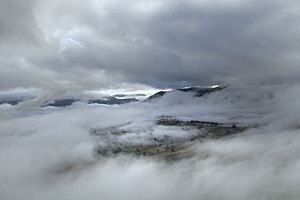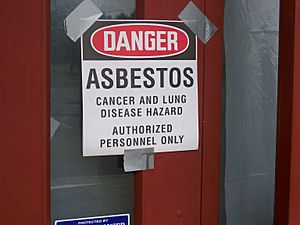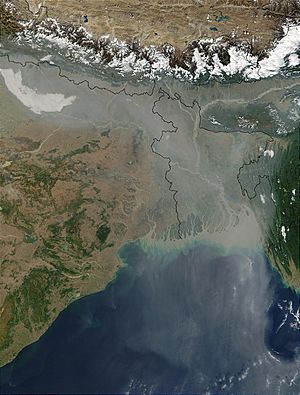Aerosol facts for kids
Technically, an aerosol is a suspension of fine solid particles or liquid droplets in a gas. Examples are smoke, oceanic haze, air pollution, and smog. In general conversation, aerosol usually refers to an aerosol spray can or the output of such a can.
The term aerosol, derives from the fact that matter "floating" in air is a suspension (a mixture in which solid or liquid or combined solid-liquid particles are suspended in a fluid). With studies of dispersion in air, the term aerosol evolved and now includes both liquid droplets, solid particles, and combinations of these. An aerosol may come from sources as various as a volcano or an aerosol can.
Aerosols have many technological applications including in medicine and aerosol science which cover a wide range of topics, such as generation and removal of aerosols, technological application and their impacts on the environment and people.
Atmospheric aerosols
Earth's atmosphere contains aerosols of various types and concentrations, including quantities of:
- natural inorganic materials: dust, smoke, sea salt, water droplets
- natural organic materials: pollen, spores, bacteria
- anthropogenic products of combustion such as: smoke, ashes oder dusts
Aerosols can be found in urban Ecosystems in various forms, for example:
- dust
- cigarette smoke
- mist from aerosol spray cans
- soot or fumes - vehicle exhausts
The aerosols present in earth's atmosphere have many impacts including on climate and human health.
Workplace exposure
Concentrated aerosols from substances such as silica, asbestos, and diesel particulate matter are sometimes found in the workplace and have been shown to result in a number of diseases including silicosis and black lung. Respirators can protect workers from harmful aerosol exposure. In the United States the National Institute for Occupational Safety and Health certifies respirators through the National Personal Protective Technology Laboratory to ensure that they protect workers and the public from harmful airborne contaminants.
Effect on climate
Anthropogenic aerosols, particularly sulfate aerosols from fossil fuel combustion, exert a cooling influence on the climate. The cooling effect of aerosols, however, does not seem to directly counteract the warming induced by greenhouse gases such as carbon dioxide, methane and water vapor and is accounted for in climate models, despite some claims that "global dimming" by aerosols may counteract global warming.
Recent studies of the Sahel drought and major increases since 1967 in rainfall over the Northern Territory, Kimberley, Pilbara and around the Nullarbor Plain have led some scientists to conclude that the aerosol haze over South and East Asia has been steadily shifting tropical rainfall in both hemispheres southward. The latest studies of severe rainfall declines over southern Australia since 1997 have led climatologists there to consider the possibility that these Asian aerosols have shifted not only tropical but also midlatitude systems southward.
Images for kids
-
Photomicrograph made with a Scanning Electron Microscope (SEM): Fly ash particles at 2,000× magnification. Most of the particles in this aerosol are nearly spherical.
-
The same hypothetical log-normal aerosol distribution plotted, from top to bottom, as a number vs. diameter distribution, a surface area vs. diameter distribution, and a volume vs. diameter distribution. Typical mode names are shown at the top. Each distribution is normalized so that the total area is 1000.
See also
 In Spanish: Aerosol para niños
In Spanish: Aerosol para niños









